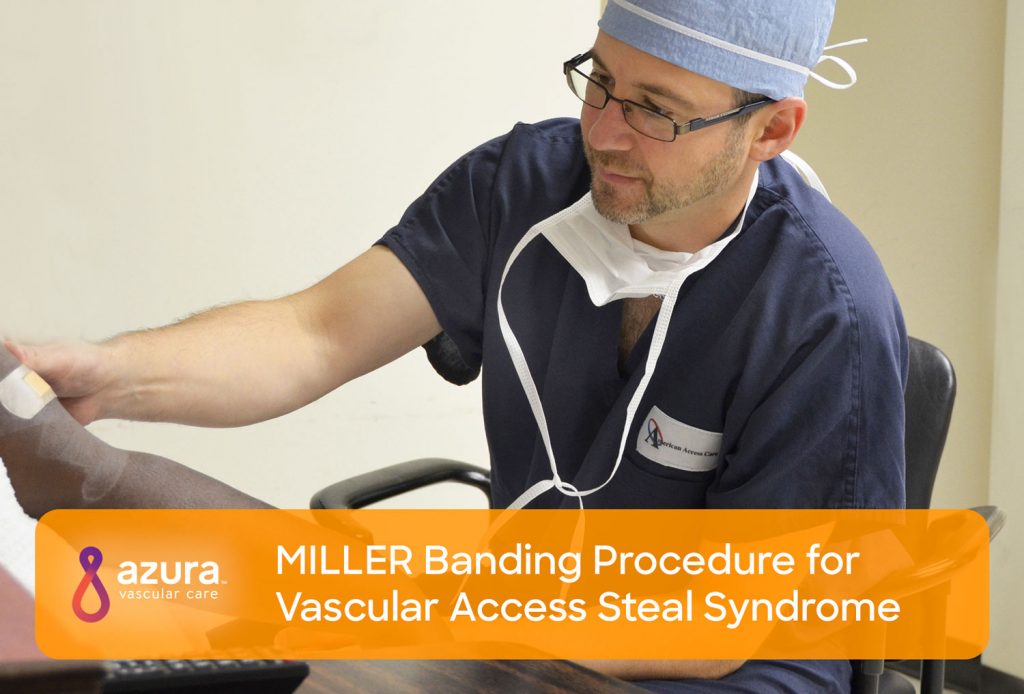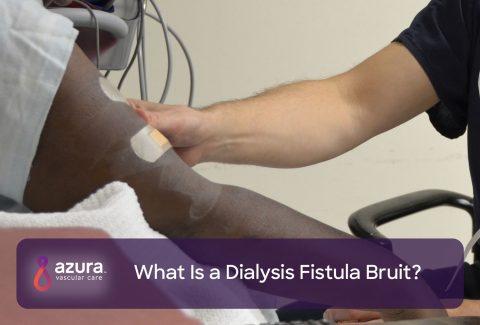
If you’re a hemodialysis patient who has a fistula or graft as your vascular access, you may be at risk for a serious health complication known as “steal syndrome.” Placement of an arteriovenous fistula (AV fistula) or graft for dialysis results in an increased blood flow rate through the vein, enlarging and strengthening the vein. This allows for large amounts of blood to flow through the access in order to filter as much blood as possible per dialysis treatment. This increase in blood flow through the vascular access can limit arterial blood flow to the forearm and hand of the same limb, resulting in steal syndrome.
Steal syndrome often begins with pain or numbness in the hand. But over time, limited blood flow to the hand can trigger more serious complications like tissue death, also known as ischemia. Approximately six percent of dialysis patients require treatment for steal syndrome. (i) Fortunately, the Minimally Invasive Limited Ligation Endoluminal-Assisted Revision (MILLER) procedure offers a minimally invasive method for improving blood flow in the affected hand and arm.
Understanding Dialysis
If you or a loved one is just starting on dialysis, you may be confused about what this treatment involves. Dialysis is a treatment for patients diagnosed with end-stage kidney failure. Healthy kidneys help to remove waste products from the blood. If the kidneys aren’t filtering your blood adequately, a dialysis machine can perform this task instead. (ii)
Dialysis patients typically have an AV fistula or a synthetic graft placed in their arm. (ii) The AV fistula or graft provides the dialysis machine with access to the patient’s blood. Blood flows from the vascular access to the dialysis machine and is returned to the vascular access.
What Is Steal Syndrome?
A significant amount of blood is directed from high-pressure arteries through the fistula or graft into the dialysis machine. In some cases, there may not be enough arterial blood still flowing to the hand. As a result, some dialysis patients suffer from ischemia, or insufficient blood flow, in the affected arm. (i)
This phenomenon is known as steal syndrome. Steal syndrome may cause the following symptoms in the affected limb: (iii)
- Pale skin
- Pain
- Weak pulse
- Low blood pressure
- Coldness
- Numbness
- Tingling or prickling in the hand or fingers
Left untreated, steal syndrome can lead to ulcers or tissue death in the hand. (i) That’s why it’s essential to treat steal syndrome right away.
What Is the MILLER Banding Procedure?
The MILLER banding procedure can help correct steal syndrome. Developed by Dr. Gregg Miller, interventional nephrologist, in 2006, the MILLER banding procedure is both highly effective and minimally invasive. (iii) The procedure uses sutures to create a band around part of the vein of the vascular access. The band adjusts blood flow through the access and improves circulation to the hand.
To begin a MILLER banding procedure, an angiogram is first performed. A contrast dye is introduced into the vein, which allows for examination of blood flow in the arm. An area is then chosen for where the band will be placed. Whenever possible, an area that is easily accessible and close to the surface of the skin is selected.
Two small parallel incisions around the vein are made. Each incision is only half a centimeter in size. A Kelly clamp is then used to create a pocket above and below the vein. A tunnel is created, connecting the two pockets.
Next, the physician threads a Prolene® suture through the tunnel. Prolene is a durable synthetic material. It’s less likely than other materials to react negatively with your skin so it can remain safely in your body. (iv) The Prolene sutures act as a band around the vein, adjusting blood flow.
A catheter is then used to insert an angioplasty balloon into the vein. The inflated balloon provides a rigid structure inside the vein. This allows the physician to adjust the size of the band with greater precision.
The angioplasty balloon helps to accurately size the band around the vein. In older procedures, it was sometimes difficult to size the bands around a flexible vein. Expensive, complex measuring equipment was often used to properly adjust blood flow. (i) With the MILLER procedure, this type of equipment is not necessary.
Finally, another angiogram is performed to determine whether blood flow in the arm has been successfully balanced. The incisions are then sutured, cleaned and bandaged. In most cases, the patient can return home shortly afterward.
What Are the Benefits of the MILLER Banding Procedure?
The MILLER banding procedure is minimally invasive and often performed as an outpatient procedure. (i) In most cases, an overnight hospital stay is not needed. The procedure also involves only tiny incisions. This helps reduce the risk of infection or scarring.
Minimally invasive procedures like this one are appealing to many patients as they usually offer a shorter recovery time. Patients can return to their normal activities sooner with a lower risk of complications.
Another advantage of the MILLER banding procedure is the Prolene sutures. These sutures are durable yet easy to adjust or remove. If you have a banding procedure, your doctor may need to make future adjustments to the bands to maintain proper blood flow. Prolene sutures make the adjustment process more manageable and less invasive. (iv)
MILLER banding procedures are also very effective. An initial banding procedure resolves steal syndrome symptoms in more than 89 percent of patients. In cases where an additional procedure is needed, more than 96 percent of patients find relief from their symptoms. (i) Because the MILLER banding procedure offers greater precision, many patients only need one procedure to resolve their symptoms.
How Azura Vascular Care Can Help
At Azura Vascular Care, our physicians are leaders in the field of vascular specialty services. Dr. Gregg Miller, developer of the MILLER procedure, is board-certified in internal medicine, nephrology and critical care medicine with additional qualifications in interventional nephrology. He is a published author, researcher and trainer of physicians, and in his role as vice president of operations at Azura Vascular Care, he oversees initiatives to ensure that all processes and procedures are aligned so that Azura patients receive the highest quality vascular care.
Azura Vascular Care physicians use cutting-edge techniques like the MILLER banding procedure to correct underlying vascular access problems without the need for invasive surgery or lengthy recovery times.
That means you’ll be able to return to your regularly scheduled hemodialysis treatments much sooner.
Call 866-996-9729 to schedule an appointment with a vascular specialist today.
Sources:
(i) Miller, G. A., Goel, N., Friedman, A., Khariton, A., Jotwani, M. C., Savransky, Y., . . . Preddie, D. C. (2010). The MILLER banding procedure is an effective method for treating dialysis-associated steal syndrome. Kidney International, 77(4), 359-366. doi:10.1038/ki.2009.461
(ii) U.S. Department of Health and Human Services. (2018, January 01). Hemodialysis. Retrieved September 12, 2018, from https://www.niddk.nih.gov/health-information/kidney-disease/kidney-failure/hemodialysis
(iii) Zamani, P., Kaufman, J., & Kinlay, S. (2009). Ischemic steal syndrome following arm arteriovenous fistula for hemodialysis. Vascular Medicine, 14(4), 371-376. doi:10.1177/1358863×09102293
(iv) Weinzweig, J., & Weinzweig, N. (2010). Plastic surgery secrets plus (2nd ed.). Philadelphia: Mosby/Elsevier. doi:10.1016/B978-0-323-03470-8.00002-8


